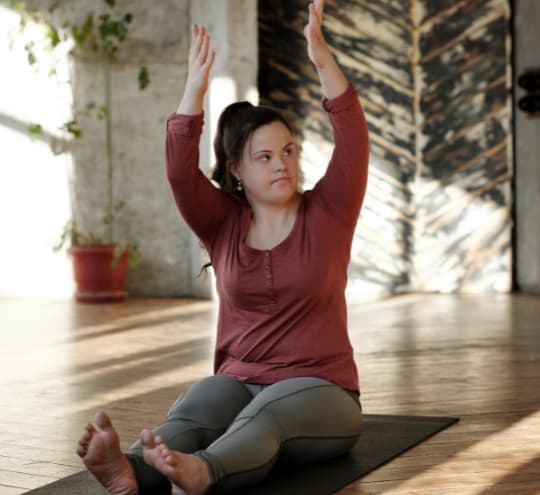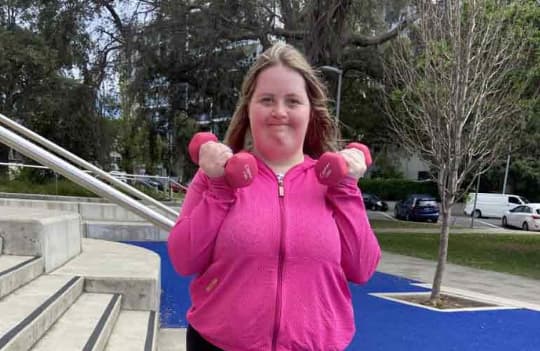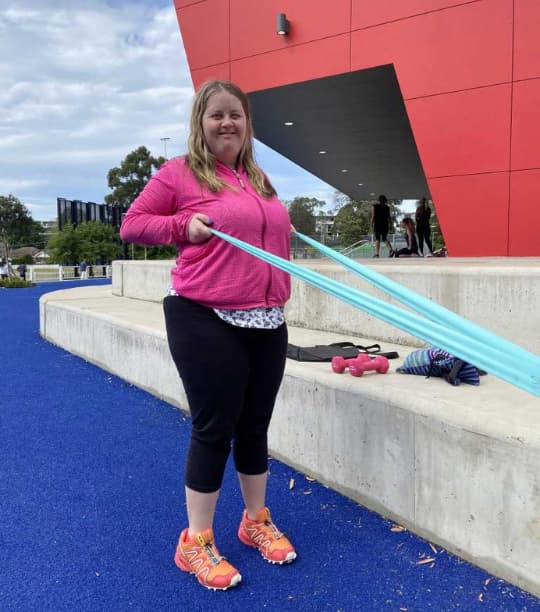Down Syndrome Exercise and Nutrition
What is Down Syndrome?
Down Syndrome is a genetic chromosomal disorder that causes intellectual and developmental delays, and physical complications including an increased risk of heart disease, hypotonia, gastrointestinal defects and hypothyroidism (Down Syndrome Australia, 2019).
Down Syndrome can result in intellectual disability, congenital heart defect, hypotonia (low muscle tone), obesity and Coeliac disease. These disability-related health conditions affect people with Down Syndrome on a daily basis and mean that additional support is often required to do things that others may take for granted like beginning new routines, preparing meals, completing chores around the home, moving and walking easily and managing money.


Down Syndrome Exercise
People with Down Syndrome have reduced exercise capacity which is a significant problem since low fitness and activity levels have been associated with reduced health and life expectancy (Mendonca et al, 2010). Reduced levels of muscle strength and low VO2peak have been shown to be determinants of poor performance in tasks of daily living which span all stages of their development. That is, it affects people with Down Syndrome at any age (Mendonca et al, 2010). As a result, Down Syndrome exercise interventions that target both children and adults are important.
More about Exercise for Intellectual Disability and Obesity
The physical activity habits of those with a cognitive impairment (as is the case in those with Down Syndrome) are far below that of the general population, and when faced with a choice of leisure activity, people with intellectual disability will most often choose to engage in activities that are sedentary in nature such as watching Television (Heller et al, 2002). Individuals with intellectual disability are also more likely to be overweight or obese than the general population due to their complex mix of behavioural, environmental and biological factors (Biswas 2020).
What is Hypotonia?
Hypotonia means decreased muscle tone (NIH, 2019). Muscle tone is regulated by signals that travel from your brain to your nerves and tell your muscles to contract (NIH, 2019). Decreased muscle tone, attributed to her Down Syndrome diagnosis, means that Bonnie may have problems with mobility and posture, breathing and speech difficulties, ligament and joint laxity, poor reflexes (NIH, 2019) and fine and gross motor skills. Exercise and physical therapy can improve motor control and overall body strength (NIH, 2019).
What about Nutrition for Down Syndrome?
Coeliac disease is more common in individuals with Down syndrome who have a higher susceptibility for autoimmune conditions (Beyond Coeliac, 2020), and the treatment for coeliac disease is total removal of gluten-containing food from the diet. If gluten isn’t removed from the diet, short-term complications can include gut symptoms like bloating, constipation and diarrhoea. Long-term complications of poorly managed Coeliac disease can be as severe as bowel cancer. Therefore, it is very important that Bonnie adheres to a gluten-free diet!

Case Study:
How exercise and nutrition helped Bonnie maintain independence

Meet Bonnie, a young woman who loves getting her nails done, going shopping, watching Netflix, catching up with her best friend, and all things cats. Bonnie has been receiving support from Active Ability with both an exercise program from her exercise physiologist Adelle, and a diet and nutrition plan from her dietitian Amanda, so that she is able to achieve her NDIS goals. Over the past three months, Bonnie has made amazing progress with her Down Syndrome exercises and nutrition plans, and should be commended for her hard work!
Exercise is important for everyone for a number of reasons but for Bonnie, it’s particularly important to manage her disability by counteracting her low muscle tone and obesity so that she can maintain her independence. Therefore, Bonnie’s exercise physiology intervention has focused on exercise to improve her upper body and lower body strength, fitness, balance and coordination in order to work towards her NDIS goals.
Due to her intellectual disability, Bonnie has not been engaging in enough physical activity, is considered obese and has a reduced capacity to understand nutrition, exercise and health information. She is therefore reliant on others, such as an exercise physiologist and dietitian, to ensure she has good holistic health.
NDIS Exercise Physiology
Bonnie has enjoyed beginning her Down Syndrome exercise routine down at the local park and is now completing her exercise program up to 5 times per week! This is because her exercise program is both fun and rewarding. Given this large increase in physical activity, as a result Bonnie has experienced improvements in her strength and aerobic capacity. Bonnie has support workers who help her with various tasks during her week. It’s been an important part of her exercise sessions to involve Bonnie’s support workers so that they are able to support her with building up her exercise routine. Bonnie’s support worker’s involvement adds to Bonnie’s enjoyment and it has been great to see that as a result of the exercise physiology intervention, Bonnie’s support worker has seen the benefits and enjoys completing the exercise with Bonnie too!
Now that Bonnie has embedded Down Syndrome exercise into her weekly schedule so that it has become ‘the norm’, she is very much enjoying her routine. The next step for Bonnie when working with Adelle her exercise physiologist is to decrease the amount of time she spends sitting each day and to increase the intensity of her exercise so she experiences even more improvements to her strength, fitness and overall physical function.
This is so that Bonnie can work towards the physical activity guidelines of at least:
- 150 minutes of moderate intensity physical activity (ideally something every day)
- 2 strengthening sessions each week
- minimising the amount of time spent sitting (The Department of Health, 2019).
It’s important that Bonnie aims for these physical activity guidelines as they have been proven to optimise health and wellbeing and decrease the risk of obesity and chronic disease (such as heart disease and diabetes) (The Department of Health, 2019). More regular exercise at a greater intensity will help Bonnie feel fitter and stronger and make tasks like climbing stairs, going shopping and lifting objects much easier for her.


Nutrition & Dietetics for Down Syndrome
Nutrition is also incredibly important for Bonnie, and due to conditions related to her Down Syndrome it is harder for Bonnie to achieve a regular, healthy diet. Firstly, Bonnie has coeliac disease which is an autoimmune condition where the small bowel is damaged leading to a defect in the absorption of nutrients (Centre for Digestive Diseases, 2020).
In addition to having coeliac disease, Bonnie also has an intellectual disability which reduces her capacity to understand the need for a healthy diet in improving general health and wellbeing and preventing constipation. When she first started seeing her dietitian, Bonnie didn’t eat any vegetables nor drink any water. This meant that she had an increased reliance on unhealthy food and drinks like soft drink. Since working with her dietitian, Bonnie has improved her understanding of healthy eating, the importance of variety in her diet and she now consumes some water and vegetables! She also has noticed a little bit of weight loss.
A healthy diet has many benefits for Bonnie, including the prevention of chronic disease, reducing body weight, improving mobility and reducing bowel symptoms. Bonnie has achieved so much this year and she is motivated to continue working on slowly improving her diet to be as healthy as she possibly can and fit into her old formal dress!
Bonnie has worked hard to learn how to improve her health and wellbeing by engaging in more regular physical activity and consuming a greater variety of foods and fluids from the recommended core food groups.
Great work, Bonnie!
Active Ability are experts in mobile disability therapy. We see clients with intellectual disability in the comfort of their homes. Or, like we did with Suzie, we can see you in an environment that is suited to your needs and goals, such as a gym, pool or your local area.
Click here if you would like to know more about how our team could help you or someone you know achieve better health and wellbeing,
Or get in touch with us on (02) 8678 7874, hello@activeability.com.au or via our contact form.
References:
- Beyond Celiac (2020). [online] Available at: https://www.beyondceliac.org/celiac-disease/related-conditions/down-syndrome/
- Biswas, A. et al., 2016. Obesity in People with Intellectual Disabilities. Intellectual Disability & Health, University of Hertfordshire. [online] Available at: https://www.intellectualdisability.info/physical-health/obesity-in-people-with-intellectual-disabilities
- Centre for Digestive Diseases (2020). Coeliac Disease. [online] Available at: https://centrefordigestivediseases.com/coeliac-disease/
- Down Syndrome Australia. (2019). What is down syndrome?[online] Available at: https://www.downsyndrome.org.au/what_is_down_syndrome.html
- Heller, T., Hsieh, K. & Rimmer, J. (2002). ‘Barriers and Supports for Exercise Participation Among Adults with Down Syndrome’ Journal of Gerontological Social Work, vol. 38, no. 1, pp. 161-178.
- Mendonca, G. V., Pereira, F. D., Fernhall, B. (2010). Reduced exercise capacity in persons with Down Syndrome: cause, effect, and management. Therapeutics and Clinical Risk Management, 6, 601-610.
- National Institute of Neurological Disorders and Stroke (2019). Hypotonia Information Page. [online] Available at: https://www.ninds.nih.gov/Disorders/All-Disorders/hypotonia-Information-Page
- The Department of Health (2019). Australia’s Physical Activity and Sedentary Behaviour Guidelines and the Australian 24-Hour Movement Guidelines. [online] Available at: https://www1.health.gov.au/internet/main/publishing.nsf/Content/health-pubhlth-strateg-phys-act-guidelines#npa1864